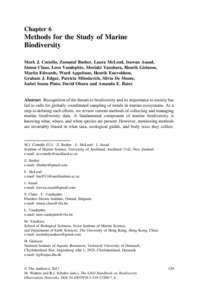| dc.contributor.author | Costello, Mark J. | |
| dc.contributor.author | Basher, Zeenatul | |
| dc.contributor.author | McLeod, Laura | |
| dc.contributor.author | Asaad, Irawan | |
| dc.contributor.author | Claus, Simon | |
| dc.contributor.author | Vandepitte, Leen | |
| dc.contributor.author | Yasuhara, Moriaki | |
| dc.contributor.author | Gislason, Henrik | |
| dc.contributor.author | Edwards, Martin | |
| dc.contributor.author | Appeltans, Ward | |
| dc.contributor.author | Enevoldsen, Henrik | |
| dc.contributor.author | Edgar, Graham J. | |
| dc.contributor.author | Miloslavich, Patricia | |
| dc.contributor.author | De Monte, Silvia | |
| dc.contributor.author | Sousa Pinto, Isabel | |
| dc.contributor.author | Obura, David | |
| dc.contributor.author | Bates, Amanda E. | |
| dc.date.accessioned | 2018-08-27T15:09:21Z | |
| dc.date.available | 2018-08-27T15:09:21Z | |
| dc.date.issued | 2017 | |
| dc.identifier.citation | Costello, M.J.; Basher, Z.; Mcleod, L. et al (2017) Methods for the Study of Marine Biodiversity. In: The GEO Handbook on Biodiversity Observation Networks (eds M. Walters and R.J. Scholes). Springer Open, pp.129-163. DOI:10.1007/978-3-319-27288-7_6. | en_US |
| dc.identifier.uri | http://hdl.handle.net/11329/500 | |
| dc.identifier.uri | http://dx.doi.org/10.25607/OBP-82 | |
| dc.description.abstract | Recognition of the threats to biodiversity and its importance to society has led to calls for globally coordinated sampling of trends in marine ecosystems. As a step to defining such efforts, we review current methods of collecting and managing marine biodiversity data. A fundamental component of marine biodiversity is knowing what, where, and when species are present. However, monitoring methods are invariably biased in what taxa, ecological guilds, and body sizes they collect. In addition, the data need to be placed, and/or mapped, into an environmental context. Thus a suite of methods will be needed to encompass representative components of biodiversity in an ecosystem. Some sampling methods can damage habitat and kill species, including unnecessary bycatch. Less destructive alternatives are preferable, especially in conservation areas, such as photography, hydrophones, tagging, acoustics, artificial substrata, light-traps, hook and line, and live-traps. Here we highlight examples of operational international sampling programmes and data management infrastructures, notably the Continuous Plankton Recorder, Reef Life Survey, and detection of Harmful Algal Blooms and MarineGEO. Data management infrastructures include the World Register of Marine Species for species nomenclature and attributes, the Ocean Biogeographic Information System for distribution data, Marine Regions for maps, and Global Marine Environmental Datasets for global environmental data. Existing national sampling programmes, such as fishery trawl surveys and intertidal surveys, may provide a global perspective if their data can be integrated to provide useful information. Less utilised and emerging sampling methods, such as artificial substrata, light-traps, microfossils and eDNA also hold promise for sampling the less studied components of biodiversity. All of these initiatives need to develop international standards and protocols, and long-term plans for their governance and support. | en_US |
| dc.language.iso | en | en_US |
| dc.publisher | Springer Open | en_US |
| dc.rights | Attribution-NonCommercial 2.5 | * |
| dc.rights.uri | http://creativecommons.org/licenses/by-nc/3.0/igo/ | * |
| dc.subject.other | Biodiversity | en_US |
| dc.subject.other | Geo BON | en_US |
| dc.subject.other | Biological sampling | |
| dc.subject.other | Monitoring | |
| dc.title | Methods for the Study of Marine Biodiversity. | en_US |
| dc.type | Book Section | en_US |
| dc.description.status | Published | en_US |
| dc.description.notes | Open access. Paper uploaded to ResearchGate by M Costello | en_US |
| dc.description.refereed | Refereed | en_US |
| dc.format.pagerange | pp.129-163 | en_US |
| dc.identifier.doi | 10.1007/978-3-319-27288-7_6 | |
| dc.subject.parameterDiscipline | Parameter Discipline::Biological oceanography::Biota abundance, biomass and diversity | en_US |
| dc.subject.dmProcesses | Data Management Practices::Data acquisition | en_US |
| dc.subject.dmProcesses | Data Management Practices::Data processing | en_US |
| dc.subject.dmProcesses | Data Management Practices::Data quality control | en_US |
| dc.description.currentstatus | Current | en_US |
| dc.contributor.editorparent | Walters, M. | |
| dc.contributor.editorparent | Scholes, R.J. | |
| dc.title.parent | The GEO Handbook on Biodiversity Observation Networks. | en_US |
| dc.description.sdg | 14.2 | en_US |
| dc.description.sdg | 14.A | en_US |
| dc.description.eov | Phytoplankton biomass and diversity | en_US |
| dc.description.eov | Zooplankton biomass and diversity | en_US |
| dc.description.eov | Fish abundance and distribution | en_US |
| dc.description.eov | Microbe biomass and diversity | en_US |
| dc.description.bptype | Best Practice | en_US |
| dc.description.bptype | Handbook | en_US |
| obps.contact.contactemail | m.costello@auckland.ac.nz | |
 Repository of community practices in Ocean Research, Applications and Data/Information Management
Repository of community practices in Ocean Research, Applications and Data/Information Management

